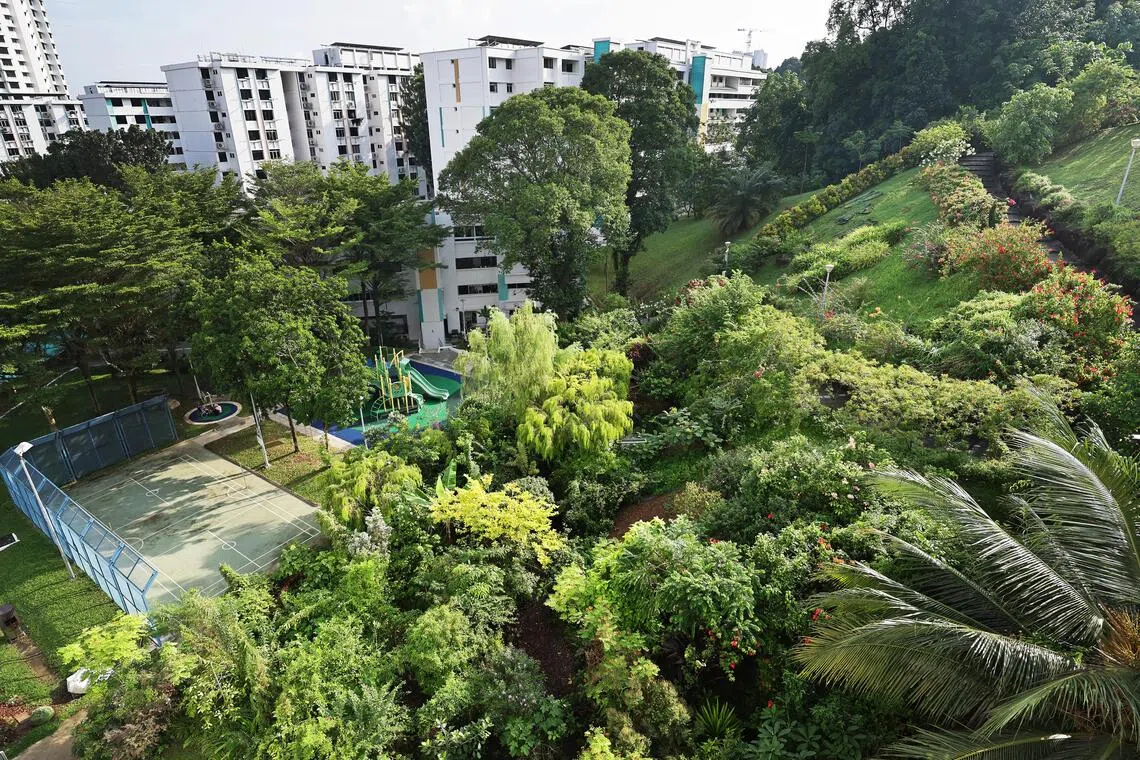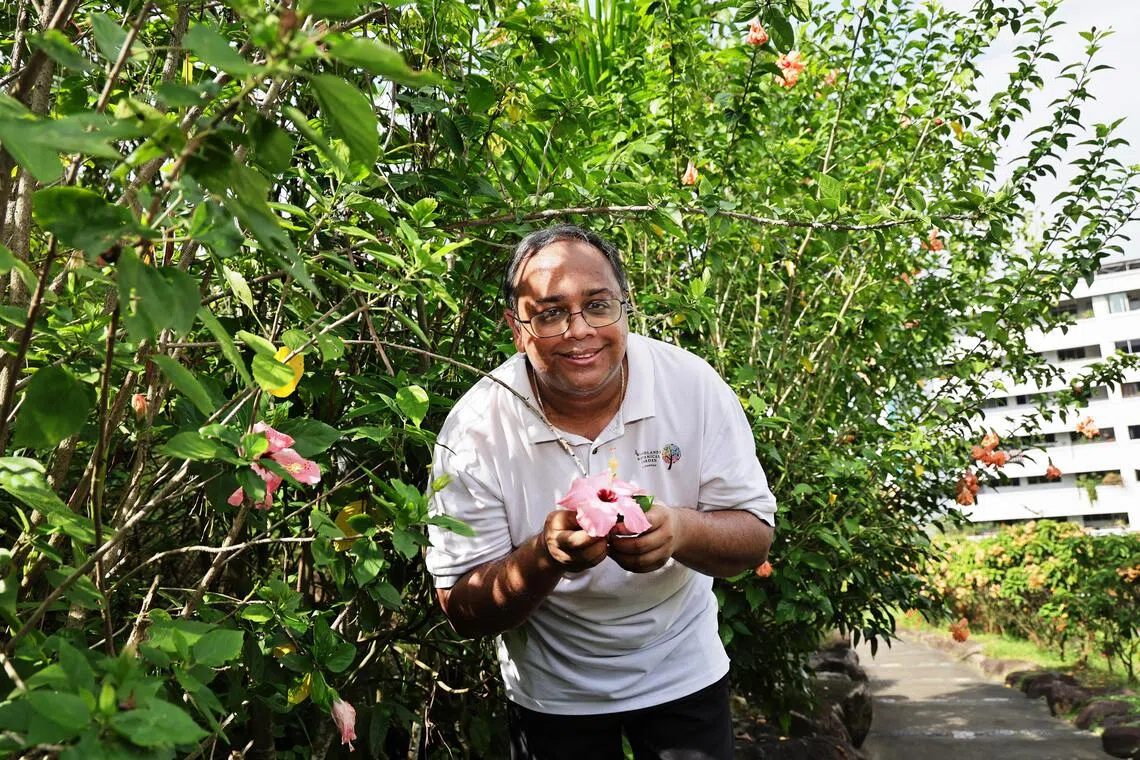SINGAPORE – When the clouds part and sunlight pours in, the Woodlands Botanical Garden (WBG) springs to life. Amid the chirping crickets, butterflies flit from flower to flower while dragonflies dart around a pond.
It all started in 2020 when Mr Ganesh Kumar, 40, decided to plant a pink hibiscus tree in memory of his late mother. Gardening was a family activity he regularly did with his parents and grandparents, who used it to instil in him the value of being responsible and caring for things.
Mr Ganesh’s meticulous care for the garden is evident. He would observe the biodiversity closely to understand which plants the animals liked.
“In nature, butterflies are sensitive to air quality and dragonflies are super sensitive to water quality. So if you see these two in a garden, you know that everything is fresh and clean. It is a space you would want to be in,” he said.
The presence of such wildlife was unthinkable just five years ago. Located at the northern slope of Woodlands Town Park East, the garden used to be a barren nine-storey-high hill covered with grass and lalang, with few signs of fauna.
Mr Ganesh, who can see the hill from his flat, decided to plant a pink hibiscus tree there to help him overcome his grief of losing his mum. He also knew the “flowers will make people happy”.
“My intention was to share how this (garden) can help others to overcome their grief… I wanted other people to experience the healing that I received from it,” he said.
Mr Ganesh said he would see families carrying seniors on wheelchairs up the stairs to the garden. “It’s so lovely to see families actually doing this for their loved ones,” he added, noting that the climb up the hill took them 30 to 40 minutes.
A resident told Mr Ganesh that his mother had wanted to go to the garden despite having to use a wheelchair, and that after she died, he would remember her whenever he visited the garden.
WBG is the largest community garden under the National Parks Board’s gardening programme, Community In Bloom. It spans 4,000 sq m, with about 10 volunteers helping to tend the place weekly.
It was initially just a 50 sq m garden managed by Mr Ganesh, his father and his former helper, but people in the community soon asked if they could volunteer. Some had no gardening experience.
“It all happened very organically,” he said.
Today, the garden is home to over 300 plant species and 300 animal species, including multiple vulnerable species in Singapore.

Plants at the Woodlands garden include the ylang ylang (Cananga odorata), a tropical tree with bright yellow flowers that produces a floral and fruity scent.
ST PHOTO: KELVIN CHNG
For instance, WBG is one of about six spots in Singapore that is home to the common birdwing (Troides helena cerberus). It is the only location where this forest butterfly can be spotted outside of large nature reserves and forested areas, Mr Ganesh said. –
More than just a garden, WBG has transformed into a community space that hosts some 20 major events yearly, such as cultural concerts, biodiversity talks and pet walks.
“I wanted to create a space where people can come and contribute to the community easily,” Mr Ganesh said, adding that he mainly plays a facilitating role, removing red tape and helping ideas reach fruition.
Many residents have suggested initiatives and taken charge of events at WBG, including young people, who make up the majority of his volunteers. For instance, they give biodiversity talks at the garden alongside experts in the field.
Noting that WBG is also “a garden of second chances for many people”, Mr Ganesh said it works closely with Human-Animal Bond In Ministry (HIM), a social enterprise that uses animal-assisted intervention to help prisoners and former offenders.
WBG and HIM have teamed up to help ex-offenders under a Singapore Prison Service initiative where volunteering at the garden is listed as one of the activities under the Desistor Network.
The monthly sessions offer former offenders the opportunity to co-facilitate animal-assisted activities at the garden or carry out gardening work. HIM gives them a stipend of $50 each for their efforts. Around 40 ex-offenders have benefited from the programme.
“Ganesh has always been very friendly and supportive to our ex-offenders, giving them words of affirmation and being very understanding of their plight,” said Ms Adeline Wong, the 48-year-old founder and director of HIM, noting that he is a role model to many of them.

Woodlands Botanical Garden spans 4,000 sq m, and is home to over 300 plant species and 300 animal species.
ST PHOTO: KELVIN CHNG
To focus on WBG, Mr Ganesh quit as a graduate research officer and took a pay cut to become a tuition centre teacher. He also gave up his PhD candidacy in material science at Nanyang Technological University.
He even sold his car to fund the installation of a pond at the garden.
One of the challenges he has faced is the theft of seeds and flowers from the garden. Some plants and trellises were also destroyed.
He said a young girl had entrusted him with a palm tree that she planted from a seed. “The plant was doing so well, then someone decided to chop down the tree and threw it by the side”, he added.
Mr Ganesh also has to navigate red tape, which he feels can be ambiguous.
“When I read some of the paperwork, I have no idea how I am supposed to respond,” he said, noting that this could be a barrier for people who want to do good but are not paperwork-savvy.
While finding partners and funding can be difficult, he is glad that the Singapore Government Partnerships Office (SGPO) was launched in 2024 to serve as a “first stop” for individuals and interest groups keen to partner the Government.
SGPO has since linked him up with the relevant government agencies and helped him secure funding from government grants such as the SG Eco Fund.
Despite these challenges, Mr Ganesh feels the garden is worth the effort.
“We have made a lot of sacrifices to start and run this garden,” he said. “But seeing all the butterflies around me and finding new flowers on trees that I forgot I planted gives me a lot of hope and renews my strength.
“Nature doesn’t tell you ‘thank you’, but you can feel it.”
He is also grateful to the residents for chipping in during his time of need, recalling how he wanted to do a light-up on Christmas Eve in the first year of the community garden.
As he struggled with a failing battery, several residents, some of them strangers, came to his aid. Together, they improvised by using LED lights from other parts of the garden to create a makeshift Christmas tree with lights.
“In many ways, it was a terrible-looking Christmas tree. But to me, it was the most beautiful Christmas tree ever,” he said. “Seeing the community come forward to work together spurs me to continue doing the things that I do.”

